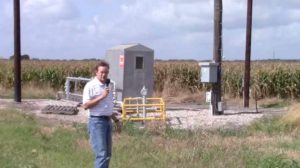In negotiating pipeline easements, the company will often ask for an easement for cathodic protection equipment. What is cathodic protection? Attorney Philip Hundl answers that question in this video and he’s included additional videos below that provide more in-depth explanations of cathodic protection for pipelines. Call 800-266-4870 for an appointment with Mr. Hundl or click this link to request a no-obligation case evaluation.
Summary of the Cathodic Protection Video
– Hi, I’m Phillip Hundl, I’m an attorney with Land Rights Law. We handle cases throughout Texas, throughout the Gulf Coast. My practice area focuses on the representation of landowners in condemnation cases.
Condemnation cases could include public entities and it could include private entities, using the power of eminent domain to acquire either easements over a private landowner’s property or actually taking parts of that land in a fee simple taking.
So we’ve had some videos before talking about eminent domain versus condemnation and what those terms mean. And so today, I’d like to focus on something that’s very important part of those easements. When a public or private entity is seeking an easement, over landowner’s property, those easement terms and that easement agreement is going to run with the land for potentially ever. Typically that is the case. It’s a perpetual easement running with the land so we want to pay close attention to the terms of those easements.

In the pipeline context we’re paying close attention to the width of the easement, the pipeline, the depth of the pipeline, how many pipelines can be within that easement. So, a lot of focus is oftentimes underground and what’s going underground with the number of pipes, the diameters of the pipes, but we also need to pay close attention to what can occur above ground. In that easement agreement, it will oftentimes allow the grantee, which will be the pipeline company, to do certain things above ground or on the surface. And allow certain facilities or equipment to be above ground or on the surface. And those facilities can also be referred to oftentimes in easement agreement as facilities or as appurtenances to the easement agreement or easement areas. So either facilities or appurtenances to the easement.
The facilities can include a lot of different things. You’ll see the terms, pipeline markers, you’ll see cathodic protection, test leads, and cathodic protection equipment. I get lots of questions on exactly what are cathodic protection test leads or cathodic protection equipment. So, I’ve found some helpful videos that explain cathodic protection. Some are short with animations. Another is quite lengthy from a company that actually installs cathodic protection. (See below)
A Short Explanation of Cathodic Protection
So with that, just briefly, I’ll explain the gist of cathodic protection. The pipelines that are installed by these pipeline companies are almost in all cases steel and so they’re metal. Metal will corrode so to slow down or prevent corrosion, a cathodic protection system is needed. That means preventing corrosion to that metal. It’s preventing corrosion to the metal through using electrical current, technical terms, and I’m not an engineer but it’s electrochemistry, so by using electrical DC current, that allows or prohibits the process of corrosion in the metal.
You’ll see in these videos, they refer to a sacrificial metal, an anode. In place of the pipeline corroding, a current is distributed in such a way that there’s positive and negative current. The right type of current is sent to the anode. The other type of current and you’ll see in the videos how it shows. So the proper current is sent to the pipe, the metal in the pipe, or the pipe to protect it and then the other current is sent to the anode and the anode is, once again, going to be the metal that’s going to corrode, and sacrifice itself to corrode instead of the pipeline or the pipe.
So with that, take a look at these videos. I think they’re helpful. Once again, this goes to what is it meant by cathodic protection. The test leads are just that. They are a method in which, or equipment, that allows measuring the amount of corrosion that could or could not be happening. The cathodic protection equipment oftentimes refers to rectifiers that are actually sending down the currents.
You need to know, what could be on the surface of your property, near or in the easement area or on land of the landowners adjacent to the easement areas.
Always when faced with a condemnation action as a landowner, please be aware of your rights. Contact an attorney who understands the condemnation process, and someone who has handled cases against pipeline companies. So that you’ll be well informed so that you can make decisions. With that, good luck and take a look at the videos.
https://youtu.be/RQtChQziSy8
Call 800-266-4870 or text 979-320-9320 for an appointment. We can also arrange for online and telephone appointments all over Texas.